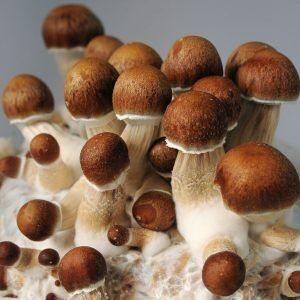
A Comprehensive Guide to Mushroom Spores: Growing at Home, Risks, Benefits, Best Strains, and Use Cases
A Comprehensive Guide to Mushroom Spores: Growing at Home, Risks, Benefits, Best Strains, and Use Cases Mushrooms are fascinating fungi with diverse applications ranging from culinary delights to medicinal uses. Growing mushrooms at home from spores is an engaging activity that can yield rewarding results. This guide covers the essentials of growing mushroom spores at home, their risks and benefits, the best strains to cultivate, and their various applications. What Are Mushroom Spores? Mushroom spores are the reproductive units of mushrooms, similar to seeds in plants. These microscopic cells are released by mature mushrooms and, under the right conditions, germinate to form mycelium — a network of fungal threads that eventually produce mushrooms.
Spores can be obtained from specialized suppliers as spore prints or spore syringes, which are sterile solutions containing spores suspended in water.
How to Grow Mushrooms from Spores at Home
- Gather Materials To grow mushrooms, you’ll need:
Mushroom spores (spore syringe or spore print) Sterile substrate (e.g., brown rice flour, sawdust, or straw) Jars or grow bags Pressure cooker or sterilizer Growing container or monotub Gloves and alcohol for sterilization 2. Prepare the Substrate The substrate provides nutrients for the mycelium. Common substrates include a mix of brown rice flour, vermiculite, and water. Fill sterilized jars or grow bags with the prepared substrate.
-
Inoculate the Substrate Using a spore syringe, inject spores into the substrate through small holes in the jar or bag. Ensure everything is sterilized to prevent contamination.
-
Incubate the Mycelium Place the inoculated substrate in a warm, dark place (65–75°F). Over several weeks, the spores will germinate and grow into mycelium, which will colonize the substrate.
-
Fruiting Stage Once the substrate is fully colonized, transfer it to a fruiting chamber with high humidity and indirect light. Maintain a temperature of 60–70°F. Mushrooms will start to appear within 7–14 days.
-
Harvest When the mushrooms are mature, gently twist and pull them from the substrate. Harvesting at the right time ensures optimal flavor and potency.
Risks of Growing Mushroom Spores
- Contamination Improper sterilization can lead to contamination by mold or bacteria, ruining the batch. Always work in a clean environment and use sterile tools.
- Legal Risks Growing certain species, like Psilocybe cubensis (magic mushrooms), may be illegal in your area. Research local laws before proceeding.
- Allergies Handling spores or mycelium may cause allergic reactions in some individuals.
- Toxicity Mistaking a toxic species for an edible or medicinal one can have severe health consequences. Benefits of Growing Mushroom Spores
- Fresh Supply Home cultivation ensures a constant supply of fresh mushrooms, free of chemicals or preservatives.
- Cost-Effective Growing mushrooms at home is more affordable than buying them in stores, especially for gourmet or medicinal varieties.
- Medicinal Properties Certain mushrooms, like Lion’s Mane and Reishi, offer health benefits, including cognitive enhancement and immune support.
- Eco-Friendly Mushrooms can be grown using recycled agricultural waste, reducing environmental impact.
- Educational Cultivating mushrooms is a fun and educational experience for individuals and families. Best Mushroom Strains to Grow **1. Edible Strains Oyster Mushrooms (Pleurotus spp.):
Easy to grow. Excellent for beginners. Culinary use in stir-fries, soups, and sauces. Shiitake (Lentinula edodes):
Rich, umami flavor. Requires wood-based substrates. Portobello (Agaricus bisporus):
Versatile and commonly used in cooking. 2. Medicinal Strains Lion’s Mane (Hericium erinaceus):
Supports brain health and cognitive function. May alleviate symptoms of anxiety and depression. Reishi (Ganoderma lucidum):
Boosts immunity and reduces stress. Commonly brewed into teas. Turkey Tail (Trametes versicolor):
Known for its cancer-fighting properties. 3. Psychoactive Strains (Where Legal) Psilocybe cubensis: Contains psilocybin, a compound known for its psychedelic effects. Used in microdosing for mental health benefits. Use Cases of Mushrooms
-
Culinary Mushrooms are a staple in global cuisines. Edible mushrooms add flavor, texture, and nutrition to dishes like soups, salads, and pasta.
-
Medicinal Immune Support: Reishi and Turkey Tail enhance immune function. Mental Health: Lion’s Mane improves cognitive function, and psilocybin mushrooms (where legal) are used to treat depression and PTSD.
-
Environmental Bioremediation: Mushrooms can break down toxic substances in the environment. Composting: Mycelium enhances soil quality by decomposing organic material.
-
Industrial Packaging: Mushroom-based materials serve as eco-friendly alternatives to plastic. Textiles: Mycelium is used to create sustainable fabrics.
-
Recreational In places where psilocybin is legal, magic mushrooms are used for spiritual and recreational experiences.
To end Growing mushrooms from spores at home is a rewarding journey, offering fresh produce, medicinal benefits, and eco-friendly solutions. While there are risks, these can be minimized with proper knowledge and precautions. Whether you’re interested in gourmet strains like Oyster and Shiitake, medicinal varieties like Lion’s Mane, or exploring the psychoactive properties of Psilocybe cubensis (in legal areas), mushrooms are a versatile addition to your home and lifestyle. Always ensure you comply with local laws and prioritize safety in your cultivation practices.